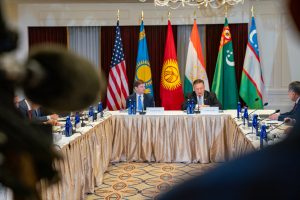In a recent opinion piece published by The Hill, Frederick Starr and Svante Cornell of the American Foreign Policy Council’s Central Asia Caucasus Institute argue that with the release of the new U.S. Central Asia strategy Washington is finally paying attention to the region.
“In releasing this strategy, the Trump administration makes clear that it views Central Asia as a world region where the United States has intrinsic national security and economic interests,” they write. “This is an important departure from the past practice of allowing this region to slip between the cracks.”
In making their argument, Starr and Cornell make an astounding statement which, if not erroneous, is misleading. U.S. interest in Central Asia isn’t new, and its strategy isn’t either.
“[The release of the Central Asia strategy] marks the first time in more than two decades that the United States has come up with a serious approach to a region where vast economic, geopolitical, and civilizational stakes are at issue,” they state in their opening paragraph.
This could not be further from the truth.
In 2015, Washington approved a strategy for the region. Indeed, the new strategy acknowledges — as do the diplomats tasked with trotting it out for public consumption — that it builds on the previous strategy. That earlier strategy, publicized as an “Enduring Vision for Central Asia” itself built off Secretary of State Hillary Clinton’s earlier 2011 “New Silk Road.”
Washington has not lacked a serious approach to the region, I would argue, but rather the conditions in Central Asia were not conducive to previous U.S. strategies achieving much success. This is evidenced by the fact that successive U.S. strategies are marked by continuity — the focus remains the same down the line — rather than sideways leaps in strategic thinking.
In November 2015, then-U.S.Secretary of State John Kerry visited all five Central Asian states in a single swooping trip that began in Uzbekistan. In the ancient Silk Road bastion of Samarkand, Kerry opened the first C5+1 ministerial with the following remarks:
To begin with, let me just say that the United States does support the sovereignty and the territorial integrity and the independence of each country that is represented here. And it’s very important for the countries of the region, in our judgment, to have healthy and mutually beneficial relations among yourselves, each of you, country to country, but also with neighbors and with all countries. And that’s really what brings us here.
It is not without precedence that the new U.S. strategy is centered around what Ambassador Alice Wells, principal deputy assistant secretary for South and Central Asia, called the “holy trinity”: independence, sovereignty, and territorial integrity. And there — back in 2015 — we can see statements of U.S. interest in greater regional cooperation.
The C5+1 has become one of the most successful vehicles for U.S. relations with Central Asia since, one that the Trump administration has continued to use as conditions on the ground in Central Asia have become more fertile for cooperation. Nowhere do Starr and Cornell mention the format by name, a critical oversight.
Central Asia is never as important to Washington policymkers as Central Asianists believe it should be; and while the new strategy is a step forward, it is far from the first step in the maturing U.S. vision for the region.
Casting it as such ignores recent history, to say the least. And ignoring recent history also overlooks the motivating reason for the new strategy: it isn’t that Washington woke up to Central Asia under the Trump administration, but that Central Asia woke up to itself.
A strategy does not need to be groundbreakingly new to be important.

































